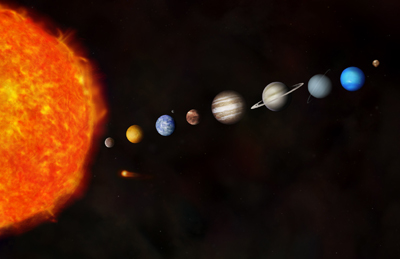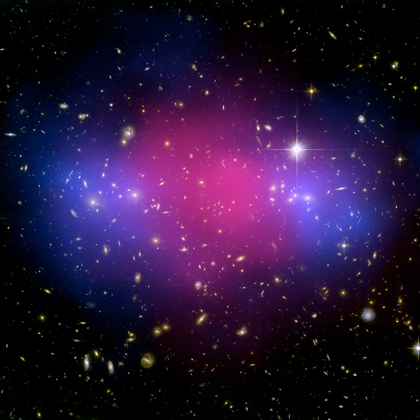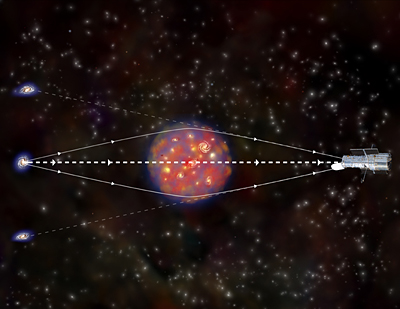How Far Away Are They?
Marusa Bradac: I do astronomy because it fascinates me. And it is the simplest things about it that amaze me most. I still remember times when I was a little girl watching stars with my dad in my home country Slovenia and wondering, "how far away are they?" I also remember how exciting it was when I first saw the Andromeda galaxy in our backyard. These days I moved on to much bigger things called clusters of galaxies. But the excitement of the question of how far away they really are is still there.

Illustration of our Solar System
Do you still remember those models of the Solar System that teachers showed you in school (where nothing was really to scale) that were so cool? Now take our Solar System, including Pluto (remember, even though not a planet anymore, it still belongs to the Solar System) and squish it to the thickness of your hair, approximately one hundredth of a millimeter. Then the next closest star, Proxima Centauri will be a meter away. And the closest galaxy to our galaxy is already 250 miles away. In fact, it is so far, that it takes the light more than 2 million years to travel to us. Further even is the closest galaxy cluster, called the Virgo Cluster, where the light we see today left it 60 million years ago. On our scale it would be already 6000 miles away from us (a distance from Santa Barbara to a tiny country where this story really started, Slovenia).
The galaxy cluster I'm most interested in these days, MACS J0025.4-1222 is even much further. The photons we are observing with Chandra and the Hubble space telescope took 6 billion years to travel to us. And since the light left it, the cluster moved even further away from us. In our model, the cluster is now at three times the distance to the Moon! And remember, we started with a hair.

Galaxy Cluster MACS J0025.4-1222
And as if this isn't enough, the cluster is actually made of two clusters that have smashed together with 5 million miles per hour. So the Universe has provided us with a cosmic accelerator. And when we weigh the cluster, it turns out that what we see is not at all what we get. We get six times more mass than we expect based on what we detect, and that “more†is dark matter. This cosmic accelerator has allowed us to study the properties of this dark matter, quite similarly to the giant collider Large Hadron Collider (LHC) built at CERN that will soon turn on. So we can say already that dark matter is, simply speaking, weird. Or anti-social. It doesn't like to play with anyone, not even photons. The only reason why we know it is there, is because it has mass and it attracts photons through gravity, altering their path as they travel, which is the effect we call gravitational lensing. But it doesn't absorb photons like your dark T-shirt does (and you know it does, because it gets hot on a summer day). Dark matter is not just dark, it is invisible. And it is all around us. If the physicists have guessed its particle mass right (and LHC will give us an answer to that) there are few dark matter particles in an average class room. Here and in Slovenia. Now if this is not fascinating!

Illustration of Gravitational Lensing
--------------
Marusa Bradac is a postdoctoral researcher at the University of California Santa Barbara, and she's also a Hubble fellow. Her main research interests include studying dark matter in galaxy clusters, figuring out gravitational lensing, and exploring the very distant Universe.
Please note this is a moderated blog. No pornography, spam, profanity or discriminatory remarks are allowed. No personal attacks are allowed. Users should stay on topic to keep it relevant for the readers.
Read the privacy statement
